Believing in the Unknown by Andres M.
The Door Behind the Wall is a collection of short stories written by H.G Wells. This work was first published in 1911 by Mitchell Kennery. The scans given include only the short story “A Dream of Armageddon” along with three images: two pictures and the leather cover of the book. The short stories omitted from the scans in the novel are “The Door in the Wall,” “The Star,” “The Cone,” “A Moonlight Fable,” “The Diamond Maker,” “The Lord of the Dynamos,” and “The Country of the Blind” (novelette). These stories mainly focus on futurism and describe utopias predicting the advent of aircraft and other technologies. Wells’s short story, “A Dream of Armageddon” was no exception. In this tale, a mysterious man enters a carriage with our protagonist and tells him of a world he dreams of every time he falls asleep that he is convinced exists. Moreso, the work contains immense imagery that beautifully illustrates the novel.
Across the three images which accompany, “A Dream of Armageddon,” one particular theme is the value of that which is hidden. The rustic pages of the leather worn book cover, the black and white photo of a mysterious coastline out in the sea, and a door hidden underneath the overgrown foliage of a dark street all show places or things that have not been seen by the common eye. The mysterious coastline is known as the Cape of Capri, and we are shown a black and white photograph of it taken by Alvin Langdon Coburn. As the publication date of the work as a whole is 1911, we know the photo is at least that old. This tells us as the readers that this place, which was seen in the mysterious man’s dreams, was, in fact, a real place. Even more so, the historical context between the man’s dream lines up all too well. That photo was taken in the midst of World War II as the man’s retelling of Capri coincides with the outbreak of war. All of this evidence coming together shows the readers the irrefutable claim that the mysterious man’s dream was no different than reality. The main character himself realized this was no imaginary dream when the mysterious man mentioned the rock I Faraglioni without visiting the region, ” ‘I know that rock’, I said, ‘I was nearly drowned there. It is called the Faraglioni.’ ” (Wells). However, this truth is only known to the mysterious man and the individuals he tells his story to. This hidden knowledge which is obtained only by those who explore the unknown is applied to each of the images given by the work. The Cape of Capri is only seen by those who have visited it, the information within a book is known by those who have read it, the passageway behind the door is only known to those who have opened it, and the experiences within a dream can only be felt by those who have dreamt it.
Additionally, the images and pages of the book give a rustic, aged feeling and present the claim that the story itself is something that holds value, something that is noted but kept hidden away. The leather cover of the book is worn down showing a large amount of use, wear, and tear. The individual pages of the book have faded from the pristine white given off by freshly printed paper with its pages now giving off darker hues as if filled with dust. However, with all of this age, the book appears to hold wisdom and knowledge of value. Furthermore, it is clear that the materials themselves are valuable thus implying that the contents are as well. On the other hand, there are only so many hands which a single book can be passed to thus making an old, well-worn book represent valued knowledge obtained by only those who could acquire it. In the same sense, The Dream of Armageddon told the story of a priceless world known only to the man who could dream of it. Only those who dream and are told of the dream are privy to the experience and knowledge of an entire world.
Despite the death and destruction which fills the dream, through several points in the story Wells emphasizes the love which the mysterious man holds for the world and the excitement which the main character listens to his story. I believe that the audience that H.G. Wells was trying to reach out to young people with ambition so that he may show them that their dreams can become a reality. For a vast portion of his life, Wells worked as a teacher and this work serves as his final lesson to young people around the world to believe in the unknown. The sentiment carried by the mysterious man in this story was that by the end of his dream the world had turned into a nightmare. The love of his life was killed, he was slain by a soldier who couldn’t understand his pleas, and forces were colliding in war. However, when looking back on the story as a whole it is clear to see how much this world meant to him. He spent his days waiting for the night so he could return to the woman he loved and dream of the place he cared more for more than reality itself. This paradox of love and hate is often placed on ideas and things we place a high value in. Yet the one moment that fear was truly expressed in the story was at its outset as the mysterious man was afraid of not being believed. However, the steadfast support of the protagonist and the evidence given by the photo of the Cape of Capri gives both the readers and the mysterious man, the courage to believe in the unknown, in the things we value, no matter how fantastical they may seem.
Photo of Cape of Capri:
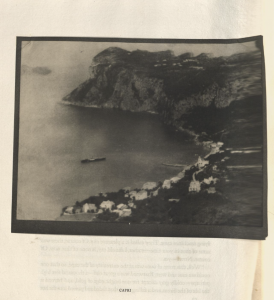
Photo of Leather Cover:

Photo of Hidden Doorway:
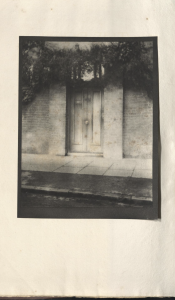


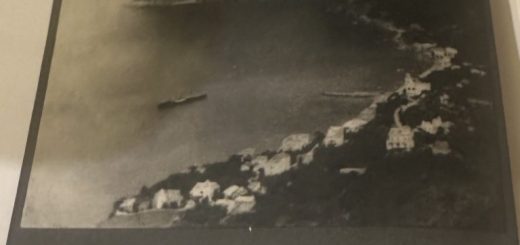




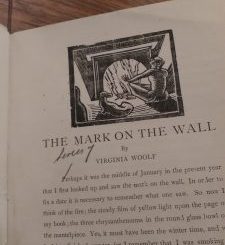

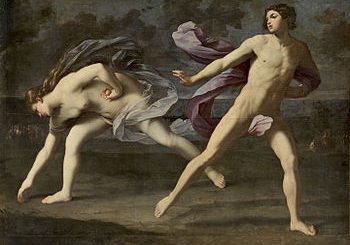
Recent Comments